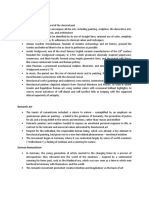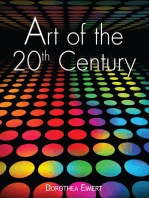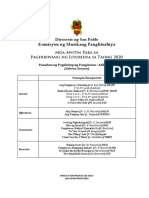0 ratings0% found this document useful (0 votes)
135 viewsArts
Arts
Uploaded by
Heart DeLa Luna VenturanzaThe document discusses the origins and key aspects of the Impressionist art movement that emerged in France in the late 19th century. The Impressionists, including Claude Monet, Auguste Renoir, and Edouard Manet, broke from past painting conventions by using visible brushstrokes, painting outdoors to capture light and movement, and depicting scenes of everyday modern life. Their use of color, subject matter, and techniques represented a dramatic shift from traditional academic painting and had a major influence on later artistic styles and movements.
Copyright:
© All Rights Reserved
Available Formats
Download as PPTX, PDF, TXT or read online from Scribd
Arts
Arts
Uploaded by
Heart DeLa Luna Venturanza0 ratings0% found this document useful (0 votes)
135 views26 pagesThe document discusses the origins and key aspects of the Impressionist art movement that emerged in France in the late 19th century. The Impressionists, including Claude Monet, Auguste Renoir, and Edouard Manet, broke from past painting conventions by using visible brushstrokes, painting outdoors to capture light and movement, and depicting scenes of everyday modern life. Their use of color, subject matter, and techniques represented a dramatic shift from traditional academic painting and had a major influence on later artistic styles and movements.
Original Description:
knhku
Copyright
© © All Rights Reserved
Available Formats
PPTX, PDF, TXT or read online from Scribd
Share this document
Did you find this document useful?
Is this content inappropriate?
The document discusses the origins and key aspects of the Impressionist art movement that emerged in France in the late 19th century. The Impressionists, including Claude Monet, Auguste Renoir, and Edouard Manet, broke from past painting conventions by using visible brushstrokes, painting outdoors to capture light and movement, and depicting scenes of everyday modern life. Their use of color, subject matter, and techniques represented a dramatic shift from traditional academic painting and had a major influence on later artistic styles and movements.
Copyright:
© All Rights Reserved
Available Formats
Download as PPTX, PDF, TXT or read online from Scribd
Download as pptx, pdf, or txt
0 ratings0% found this document useful (0 votes)
135 views26 pagesArts
Arts
Uploaded by
Heart DeLa Luna VenturanzaThe document discusses the origins and key aspects of the Impressionist art movement that emerged in France in the late 19th century. The Impressionists, including Claude Monet, Auguste Renoir, and Edouard Manet, broke from past painting conventions by using visible brushstrokes, painting outdoors to capture light and movement, and depicting scenes of everyday modern life. Their use of color, subject matter, and techniques represented a dramatic shift from traditional academic painting and had a major influence on later artistic styles and movements.
Copyright:
© All Rights Reserved
Available Formats
Download as PPTX, PDF, TXT or read online from Scribd
Download as pptx, pdf, or txt
You are on page 1of 26
At a glance
Powered by AI
The document discusses the origins and key aspects of the Impressionist art movement in the late 19th century, focusing on some of its leading artists such as Claude Monet, Auguste Renoir, and Edouard Manet. It describes how Impressionism captured the major events and trends of its time through innovative painting styles.
Impressionist artists moved away from established practices by using bolder colors, choosing everyday subjects like landscapes over formal portraits, and focusing on capturing fleeting moments and light through loose brushstrokes rather than photorealistic detail.
Some of Claude Monet's most famous works mentioned include Bridge over a Pond of Water Lilies, Irises in Monet's Garden, and several landscape paintings depicting his gardens in Giverny such as La Promenade and The Red Boats, Argenteuil.
MODERN ART
Inall of human history, art has
mirrored life in the community,
society, and the world in all its
colors ,lines, shapes, and
forms.The same has been true in
the last two centuries, with world
events and global trends being
reflected in the various art
movement.
From the industrial revolution of the late
1800s, the world zoomed into the
electronic age in the mid-1900s, then into
the present cyberspace age. In just over
100 years, humans went from hand-
cranked telephones to hands-free mobile
phones, from first auto mobiles to
interplanetary space vehicles, from local
radio broadcasting to international news
coverage via satellite, and from
vaccinations against polio and smallpox to
laser surgery.
The 20th century also suffered through two
world wars , and several regional wars in
asia, africa , and the middle east. There was
the great depression of the 1930s , and the
asian economic crisis of the 1990s.
Considered the modern-day plague, the
Acquired Immune Deficiency Syndrome
(AIDS) has afflicted millions the world
over,while millions more continue to live in
hunger, disease and poverty. Environmental
destruction and climate change have also
become major concerns.
The art movements of the late 19th century
to the 20th century captured and expressed
all these and more. Specifically, there were
the movements known as impressionism
and expressionism. While earlier periods of
an art had quite set conventions as to the
style, technique and treatment of their
subjects, impressionist and expressionist
conveyed their ideas and feelings in bold,
innovative ways. These were the exciting
precursors of the modern art of the 21st
century.
Review, briefly describe each of the following
elements of art.
1.) which you have learned in your Art classes in
the earlier grade levels.
a. line
b. shape
c. form
d. space
e. color
f. value
g. texture
Origins of the
Movement
Impressionism was an art movement
that emerged in the second half of the
19th century among a group of Paris-
based artists.The duration of the
impressionist movement itself was
quite short ,less than 20 years from
1872 to the mid-1880s.Nevertheless,
it had a tremendous impact and
influence on the painting styles that
followed, such as neo-impressionism,
post- impressionism, fauvist, and
cubism and even the artistic styles and
movements of today.
A Break from Past
Painting
Traditions
There were several areas in
which impressionist artists
moved away from the established
practices of art at that time.
These involved their use of color,
their choice of subject matter
and setting, and their technique
for capturing light and conveying
movement
The painting conventions and techniques of
earlier art periods were very much
concerned with line , form , and
composition.
In contrast , the impressionists painted with
freely brush colors (convey visual effect)
than a detailed rendering of the subject.
They used short “broken” strokes that were
intentionally made visible to the viewer.
They also often placed pure unmixed colors
side by side , rather than blended smoothly
or shaded.
Impressionists also began to break
from the creation of formally posed
portraits and grandiose depictions of
mythical, literary, historical, or
religious subjects.
They ventured into capturing scenes
of life around them, household
objects, landscapes and seascapes,
houses, cafes, and buildings.
The location in which the impressionists
painted was also different. Previously, still
lifes, portraits, and landscapes were usually
painted inside a studio. However, the
impressionists found that they could best
capture the ever-changing effects of light
on color by painting outdoors in natural
light.This gave their works a freshness and
immediacy that was a quite a change from
the stiffer, heavier,more studied paintings
of earlier masters.
Impressionist painting also moved
away from the formal, structured
approach to placing and
positioning their subjects. They
experimented with unusual visual
angles, sizes of objects that
appeared out of proportion, off-
center placement , and empty
spaces on the canvas.
Photography was in its early stages at this
time as well. As it gained popularity
photography inspired impressionists to
capture fleeting moments of action, weather
in landscapes or in the day-to-day lives of
people. But whereas camera snapshots
provided objective, true-to-life images, the
painters were able to offer a subjective view
of their subjects, expressing their personal
perceptions rather than creating exact
representations. They also had the
advantage of manipulating color, which
photography at that time still lacked
By the 1870s, the stage was set for
the emergence of the next major art
movement in europe,
Impressionism, It started with a
group of French Painters that
included Claude Monet, Auguste
Renoir, and Edouard Manet and
eventually spread to other
countries, such as Italy, Germany,
and the Netherlands.
Was a founder of French Impressionist painting
along with his friends Auguste Renoir, Alfred
Sisley, and Frederic Bazille. And the most
consistent and prolific practitioner of the
movements philosophy of expressing ones
perceptions before nature, especially as applied
to plein air landscape painting.
the most prominent of the group, and considered
as the most influential figure in the movement.
Best known for his landscape paintings,
particularly those depicting his beloved flower
gardens and water lily ponds at his home in
Giverny.
La The Red Boats,
Promenade(1875) Argenteuil(1875)
Bridge over a Pond Irises In Monet’s
of water lilies(1899) Garden (1900)
Was a french artist who was a leading painter
in the development of the impressionist
style.
Along with Claude Monet, was one of the
central figures of the impressionist
movement. His early works were snapshots
of real life, full of sparkling color and light.
By the mid-1880s, however, renoir broke
away from the impressionist movement to
apply a more disciplined, formal technique
to portraits of actual people and figure
paintings.
Dancer (1874) A Girl with a watering
can (1874)
Mlle Irene Cahen Lucheon of the
d’Anvers (1880) Boating Party (1881)
Was one of the first 19th century
artists to depict modern-life
subjects. He was a key figure in
the transition from realism to
impressionism, with a number
of his works considered as
marking the birth of modern art.
Rue Mosnier Decked
Argenteuil (1874) With Flags (1878)
Café Concert The Bar at the
(1878) Follies Bergere
You might also like
- 00 Quarterly SampleDocument6 pages00 Quarterly Sampleaissa0% (1)
- Dashing Through The SnowDocument36 pagesDashing Through The SnowtoyersinNo ratings yet
- Pride and PrejudiceDocument15 pagesPride and PrejudiceMichikoNo ratings yet
- Grammar WorksheetsDocument36 pagesGrammar WorksheetsAlejandra Zuleta100% (1)
- Steve JobsDocument4 pagesSteve JobsSandra GCNo ratings yet
- Arts 1st Quarter..yamDocument79 pagesArts 1st Quarter..yamWilliam CuisonNo ratings yet
- ARTSDocument53 pagesARTSRaign Yuan BaguioNo ratings yet
- Modern ArtsDocument31 pagesModern ArtsLambert Daniel LegaspiNo ratings yet
- Modern Art To ImpressionismDocument46 pagesModern Art To ImpressionismJoseph BoylesNo ratings yet
- Soleil Levant (In English Impression Sunrise)Document2 pagesSoleil Levant (In English Impression Sunrise)Samantha SamdayNo ratings yet
- Grade 10 Arts PPT Quarter 1 Complete W Assessment 1Document58 pagesGrade 10 Arts PPT Quarter 1 Complete W Assessment 1Regner Borneo100% (1)
- Arts Reviewer 09-17-24Document7 pagesArts Reviewer 09-17-24shiyoinnnnNo ratings yet
- Mapeh Arts W3Document12 pagesMapeh Arts W3Nicole Faye RamosNo ratings yet
- ArtsDocument13 pagesArtssheedyvyne.salasNo ratings yet
- Presentation 2Document29 pagesPresentation 2LG DirectionNo ratings yet
- Gr. 10 Arts Handouts Q1Document3 pagesGr. 10 Arts Handouts Q1JAMES LOUI ENATONo ratings yet
- ARTS 10 Quarter 1 ReferrenceDocument154 pagesARTS 10 Quarter 1 ReferrenceKen Geoffrey Daniel AtienzaNo ratings yet
- HUM101Document10 pagesHUM101Kharrel YballeNo ratings yet
- Secondary Arts 10 Q1 Module1Document7 pagesSecondary Arts 10 Q1 Module1TIPAY, EMELIE L.No ratings yet
- Gec106 Art Written ReportDocument25 pagesGec106 Art Written ReportKent riven jabianNo ratings yet
- 1Q Arts Las G10Document12 pages1Q Arts Las G10chloefloresta83No ratings yet
- ARTS 10 Read and Answer (Write Answers On 1 Whole Sheet of Paper-ANSWERS ONLY)Document8 pagesARTS 10 Read and Answer (Write Answers On 1 Whole Sheet of Paper-ANSWERS ONLY)Janine Jerica JontilanoNo ratings yet
- Modern ArtsDocument92 pagesModern ArtsJAMES LOUI ENATONo ratings yet
- Impressionism and Expressionism ArtDocument5 pagesImpressionism and Expressionism ArtAnonymous peiuZ4XFN9100% (1)
- Name: Afia Fahim & Taqveem Ali Course: Modern Poetry Semester: 3-A DATE: 19 MARCH, 2021Document3 pagesName: Afia Fahim & Taqveem Ali Course: Modern Poetry Semester: 3-A DATE: 19 MARCH, 2021Afia FaheemNo ratings yet
- Module Arts XDocument19 pagesModule Arts XEighor Man100% (1)
- ARTS 10 Quarter 1 ReferrenceDocument153 pagesARTS 10 Quarter 1 Referrencesemicolon100% (1)
- Arts10 Day1 4Document67 pagesArts10 Day1 4aris sajoniaNo ratings yet
- Arts 1stGP - Impressionism & Post - ImpressionismDocument22 pagesArts 1stGP - Impressionism & Post - ImpressionismFricx FernandezNo ratings yet
- First Quarter Modern Art Grade 10Document3 pagesFirst Quarter Modern Art Grade 10Adrian NovillaNo ratings yet
- Modern ArtDocument5 pagesModern ArtGabriel ManuelNo ratings yet
- Grade 10 Arts Q1 1Document24 pagesGrade 10 Arts Q1 1JhasminKim PendillaNo ratings yet
- Art MovementDocument11 pagesArt MovementSuzy LeeNo ratings yet
- Modern ArtDocument106 pagesModern ArtChrisseMarthaGillesania100% (8)
- ImpressionDocument4 pagesImpressionethanperumal001No ratings yet
- Final Term - Art of Emerging EuropeDocument2 pagesFinal Term - Art of Emerging EuropeDennis SimaraNo ratings yet
- Lesson Plan Mapeh 10Document3 pagesLesson Plan Mapeh 10rovelynacica201No ratings yet
- Impressionism, Neo Impressionism, Post Impressionism, Fauvism, Cubism in English Master ReaderDocument95 pagesImpressionism, Neo Impressionism, Post Impressionism, Fauvism, Cubism in English Master ReaderWrishi BiswasNo ratings yet
- Arts 10 OHSP LM FinalDocument129 pagesArts 10 OHSP LM FinalEve Mejos100% (1)
- ImpressionismDocument8 pagesImpressionismNicolás DobreNo ratings yet
- Arts Reviewer 8915Document7 pagesArts Reviewer 8915queridaria47No ratings yet
- Artapp 02.BDocument106 pagesArtapp 02.BHahahahahahahahahaNo ratings yet
- MAPEH 10 Q1 Week 2-ArtsDocument10 pagesMAPEH 10 Q1 Week 2-ArtsMyla Millapre100% (2)
- Modern Art1Document59 pagesModern Art1purposesforcodmNo ratings yet
- ACFrOgATmAH4TfZlNJfasdVHB8bZ1AOHHdLkMNLWPOKf1top4TG6t1R7gyJw8n1 Xi2d58 WNIxMT2hVVofaaWp7VRfA8DRjSzI8ENamSiWAVYikQ NLzIN4aLicQ8gBh0k4eDklfczm3U36z6i3Document6 pagesACFrOgATmAH4TfZlNJfasdVHB8bZ1AOHHdLkMNLWPOKf1top4TG6t1R7gyJw8n1 Xi2d58 WNIxMT2hVVofaaWp7VRfA8DRjSzI8ENamSiWAVYikQ NLzIN4aLicQ8gBh0k4eDklfczm3U36z6i3Mhay DingleNo ratings yet
- Grade10artsq1modernartbyme 180627160815Document53 pagesGrade10artsq1modernartbyme 180627160815Elno Jay Jamog MallorcaNo ratings yet
- 1ST Arts 10 1Document19 pages1ST Arts 10 1Mr. ZeusNo ratings yet
- Art Movement TimelineDocument4 pagesArt Movement TimelineAlleah MendozaNo ratings yet
- Arts (1st QT)Document3 pagesArts (1st QT)Adriela AlonNo ratings yet
- Aniket RajDocument5 pagesAniket Rajvishant vikashNo ratings yet
- Modern European ArtDocument8 pagesModern European ArtCassie CutieNo ratings yet
- ARTS-Q1L1 - CopyDocument62 pagesARTS-Q1L1 - CopyPatrick RamirezNo ratings yet
- Art MovementDocument16 pagesArt MovementHoney Vi PerkinsNo ratings yet
- Art Movements-1Document15 pagesArt Movements-1athreya0168No ratings yet
- MAPEH Grade 10 REVIEWER Without Elements and PrinciplesDocument6 pagesMAPEH Grade 10 REVIEWER Without Elements and PrinciplesRianne SaavedraNo ratings yet
- Grade10artsq1modernartbyme 180627160815Document53 pagesGrade10artsq1modernartbyme 180627160815Cydeizel MercadoNo ratings yet
- Impressionism 1Document35 pagesImpressionism 1joeric1No ratings yet
- MAPEH 10 Module 2Document4 pagesMAPEH 10 Module 2Evangeline Galac AbrilNo ratings yet
- Module 6 ART APPRECIATIONDocument19 pagesModule 6 ART APPRECIATIONJuliana David AustriaNo ratings yet
- Brown and Green Scrapbook Art History PresentationDocument35 pagesBrown and Green Scrapbook Art History Presentationmarcangelo.montojoNo ratings yet
- Neo Classicism To ExpressionismDocument6 pagesNeo Classicism To ExpressionismJuju OdabitNo ratings yet
- From Impressionism to Post-Impressionism - Art History Book for Children | Children's Arts, Music & Photography BooksFrom EverandFrom Impressionism to Post-Impressionism - Art History Book for Children | Children's Arts, Music & Photography BooksNo ratings yet
- Ethics Final Output FormatDocument2 pagesEthics Final Output FormatHeart DeLa Luna VenturanzaNo ratings yet
- G10-Anonas: Attendance Sheet MonthDocument1 pageG10-Anonas: Attendance Sheet MonthHeart DeLa Luna VenturanzaNo ratings yet
- Pens: 12,100: Fifteen'n One Is A Store That Is Sellin School and Office SuppliesDocument2 pagesPens: 12,100: Fifteen'n One Is A Store That Is Sellin School and Office SuppliesHeart DeLa Luna VenturanzaNo ratings yet
- Kindergarten-Dll Week 18 (October 2-6, 2017) AsfDocument13 pagesKindergarten-Dll Week 18 (October 2-6, 2017) AsfHeart DeLa Luna VenturanzaNo ratings yet
- Kindergarten-Dll Week 1 (June 5-9, 2017) AsfDocument12 pagesKindergarten-Dll Week 1 (June 5-9, 2017) AsfHeart DeLa Luna VenturanzaNo ratings yet
- Family Reunification Plan: Kindergarten - RubyDocument2 pagesFamily Reunification Plan: Kindergarten - RubyHeart DeLa Luna VenturanzaNo ratings yet
- Battletome: Flesh-Eater Courts: Official Errata, December 2019Document2 pagesBattletome: Flesh-Eater Courts: Official Errata, December 2019Adam KatzNo ratings yet
- Song HitsDocument19 pagesSong HitsWilbur Jay C. BarutNo ratings yet
- DE ECLIPSES and BeliefsDocument2 pagesDE ECLIPSES and BeliefsJonathanEncomiendaNo ratings yet
- October 31 Is Halloween. It Is A Funny Event in The: VocabularyDocument1 pageOctober 31 Is Halloween. It Is A Funny Event in The: VocabularyRodrigo Souza Santos100% (1)
- Food SheetDocument2 pagesFood Sheetbianca bat-ogNo ratings yet
- Past Simple 3 1-Put in The Past Tense The Following SentencesDocument1 pagePast Simple 3 1-Put in The Past Tense The Following SentencesnereaNo ratings yet
- Acrobat Dc. It'S How The World Gets Work Done.: View, Sign, Comment On, and Share Pdfs For FreeDocument1 pageAcrobat Dc. It'S How The World Gets Work Done.: View, Sign, Comment On, and Share Pdfs For FreeKaka kikoNo ratings yet
- Evaluative Essay On A Restaurant I Have Been To RecentlyDocument2 pagesEvaluative Essay On A Restaurant I Have Been To RecentlyAbi Saputra50% (2)
- Mukesh SongsDocument24 pagesMukesh SongsAcharla Satyanarayana100% (1)
- L3 U02 La RCDocument2 pagesL3 U02 La RCLe Thi Thanh (AL-AMES-BD)No ratings yet
- BeholdDocument3 pagesBeholdCrown Prince100% (3)
- Physics Form 4 Chapter 5: Light: Prepared By: Sharvinder SinghDocument28 pagesPhysics Form 4 Chapter 5: Light: Prepared By: Sharvinder SinghSharvinder SinghNo ratings yet
- State Common Entrance Test Cell: 2008 Government College of Engineering, AurangabadDocument35 pagesState Common Entrance Test Cell: 2008 Government College of Engineering, AurangabadAbhishek PawarNo ratings yet
- Elohim and Jehovah in Mormonism and The Bible: Boyd KirklandDocument5 pagesElohim and Jehovah in Mormonism and The Bible: Boyd KirklandSergio Armani CárdenasNo ratings yet
- Bluesletter September 2012Document32 pagesBluesletter September 2012Todd HarrisonNo ratings yet
- Advent Season 2020 DCLM San PabloDocument32 pagesAdvent Season 2020 DCLM San PabloJm CampitanNo ratings yet
- The Day The Earth Stood Still CADocument6 pagesThe Day The Earth Stood Still CANina0% (1)
- Familiaris ConsortioDocument10 pagesFamiliaris ConsortioMikee GutierrezNo ratings yet
- Zone Branch District Town Distributor CodeDocument25 pagesZone Branch District Town Distributor CodeShikhar GuptaNo ratings yet
- A Hard Day's Night: The BeatlesDocument9 pagesA Hard Day's Night: The BeatlesLucas Vieira BellonNo ratings yet
- Exercise: Create A Stop-Motion AnimationDocument26 pagesExercise: Create A Stop-Motion AnimationGeorgeKaramanoglouNo ratings yet
- Petitions From MagdolaDocument2 pagesPetitions From MagdolaNabil RoufailNo ratings yet
- Zinga Technical Data SheetDocument6 pagesZinga Technical Data SheetVikas TanejaNo ratings yet
- How To (Finally) Understand Your Dreams: Free GuideDocument13 pagesHow To (Finally) Understand Your Dreams: Free GuideEkateryna Kuzubova100% (1)
- 65 Positive Affirmations Using Scripture On TwitterDocument7 pages65 Positive Affirmations Using Scripture On TwitterShawn GriffenNo ratings yet































































































